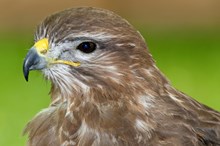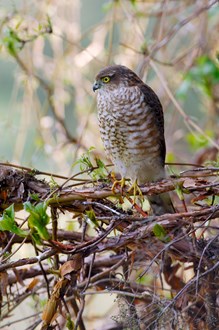06 March, 2015
Report shows mixed picture for birds of prey in Scotland
A new report published by Scottish Natural Heritage (SNH) shows some of the most complete statistical trends ever for birds of prey in Scotland, and lays the groundwork to gain even more information about raptor populations in the future.
The report shows emerging trends in the numbers and breeding success for 13 species, and finds mixed results: most species are rising, but some are falling.
Certain birds of prey, such as goshawks, buzzards and sparrowhawks, have shown signs of recovery over the past seven years from lows in the past, due to efforts to combat persecution, habitat loss and pesticides.
Not all birds of prey have increased, however, and some declines have been stark. Numbers of kestrels, a once common and widespread breeding bird, have declined. They’re now becoming scarce in many parts of Scotland.
Ron Macdonald, SNH’s director of policy and advice, said:
“I’d like to say a huge thank you to the hundreds of volunteer specialists who have helped us present, for the first time, a clear picture of what’s happening to birds of prey across Scotland.
“Some birds of prey are faring well – but our report also shows that we still have lots of work to do to make sure that all birds of prey flourish in Scotland.
“We need even more volunteers to help us monitor raptors in Scotland though, so contact the Scottish Raptor Study Group if you could lend a hand (www.scottishraptorstudygroup.org).”
Gordon Riddle, from the Scottish Raptor Study Group, said:
"We’re unsure exactly why kestrels have declined. Recent harsh winters may have led to a high mortality, but even before then kestrels were declining. It’s likely that these changes are due to a combination of factors, including habitat changes with the loss of rough grassland foraging areas and prey availability. Secondary poisoning due to rodenticides and the impact of competition and predation from the recovering raptor populations on kestrels may also be factors. A group led by the RSPB is currently analysing the situation. Although the level of monitoring has improved, there is still a great need for more coverage of this species.”
Amy Challis, the Scottish Raptor Monitoring Coordinator, added:
“This report paves the way for us to gain a greater understanding of the health of raptor populations in Scotland. The existing dedicated raptor monitoring volunteers have already provided a wealth of information, and it is now a priority for the Scottish Raptor Monitoring Scheme to build on their work. In light of the findings from this report, we will look at how we can enhance monitoring for, in particular, some of the less rare raptor species, such as kestrels, sparrowhawks and owls."
To download the full report, see http://bit.ly/1GpMTPl.
The report was written by BTO Scotland, RSPB Scotland and Haworth Conservation, funded by Scottish Natural Heritage. The data used in the report is mainly that held by the Scottish Raptor Monitoring Scheme, collected by hard-working, dedicated volunteers largely from the Scottish Raptor Study Group. The report is a starting point to gain an improved understanding in bird of prey populations across Scotland. In the future, there will be more work analysing data and finding out why populations are changing to develop our understanding of these top predators.
ENDS
Media queries
Contact SNH media officer, Vicki Mowat, on 07917 071 543 or vicki.mowat@snh.gov.uk (Tues-Fri) or the SNH main press office on 01463 725 022 (Mon).
The Scottish Raptor Monitoring Scheme (SRMS) is a partnership of eight organisations: JNCC, RSPB Scotland, SNH, BTO Scotland, SRSG, Rare Breeding Bird Panel, Scottish Ornithologists Club and Forestry Commission Scotland. It is overseen by the SRM Group chaired by SNH and aims to develop and improve raptor monitoring throughout Scotland to further the conservation of raptors, owls and ravens. It collates and analyses the annual data on breeding performance of raptors, owls and ravens in Scotland.
Contact information
- Name
- SNH Media
- snhmedia@snh.gov.uk
NatureScot is Scotland's nature agency. We work to enhance our natural environment in Scotland and inspire everyone to care more about it. Our priority is a nature-rich future for Scotland and an effective response to the climate emergency. For more information, visit our website at www.nature.scot or follow us on X at https://x.com/NatureScot
’S e NatureScot buidheann nàdair na h-Alba. Bidh sinn a’ neartachadh àrainneachd na h-Alba agus a’ brosnachadh dhaoine gu barrachd suim a chur ann an nàdar. Tha e mar phrìomhachas againn gum bi nàdar na h-Alba beairteach agus gun dèilig sinn gu h-èifeachdach le èiginn na gnàth-shìde. Tha an tuilleadh fiosrachaidh aig www.nature.scot no air X aig https://x.com/NatureScot


